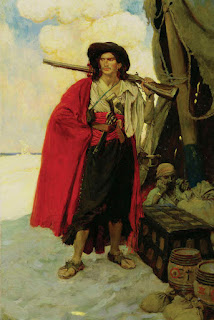 |
| Captain Keitt, 1907, by Howard Pyle |
It's one of the more popular pieces of pirate art in circulation. And if you've seen a Pirates of the Caribbean movie, you know that the influence of the artist, Howard Pyle, continues today. Historical records speak of pirates wearing finery stolen from aristocratic captives, but it was Pyle who turned the notion into the raffish fashions we still associate with the trade.
 |
| Painted 1910, the year before Pyle's death |
The Mermaid is another one of Pyle's familiar works. I'm pretty sure I still have my poster of this somewhere (continuing my habit of being unrelentingly drawn to art and objects from the Edwardian era). You can find this image printed on t-shirts and mugs and magnets and any number of other items.
 |
| "The Buccaneer was a Picturesque Fellow" 1905 (Yes, indeed he was.) |
Pyle, who was born in Wilmington, Delaware, in 1853, became well-known not only for his magazine and book illustrations, but for retellings of the legends of such classic characters as King Arthur and Robin Hood. He founded a free school of art in Wilmington, where many of his students, including Maxfield Parrish and N.C. Wyeth, went on to significant success as members of what is now known as the Brandywine School. Notably, 40 of his 110 students were women, including his sister Katharine Pyle, who became a popular illustrator of fairy tales.
His talents even extended to costuming, and he designed the costumes for the Broadway production "Springtime" in 1909. (Further proof of Pyle's continued relevance is shown by his presence in that blog and others.) On November 9, 1911, he died of illness in Florence, Italy, where he had traveled to further his own study of art. He left "The Mermaid" unfinished on his easel--so the painting we have today isn't necessarily the final vision he had planned for the work.
 |
| "Who are we that Heaven should make of the old sea a fowling net?" 1909 |
This one was new to me and I find it particularly evocative. I see a bit of Jas. Hook and Vivian Drew in it, even if it's not set in the Edwardian era of The Stowaway, or about pirates at all. Rather, it's an illustration for The Second Chance by James Branch Cabell, published in Harper's Monthly Magazine in Oct. 1909. It features a Lord Pevensey and a Lady Ormerod, a name which caught my attention as Jan Ormerod is one of my favorite Peter Pan illustrators. We come full circle again.

